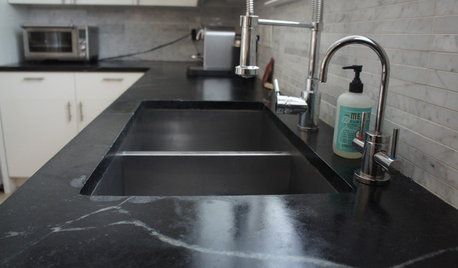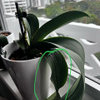lighter veins
lathyrus_odoratus
13 years ago
Related Stories

REMODELING GUIDESCarrara vs. Calacatta Marble: What Is the Difference?
The answer is in the color and veining of these popular Italian marbles
Full Story
KITCHEN BACKSPLASHESHow to Choose a Backsplash for Your Granite Counters
If you’ve fallen for a gorgeous slab, pair it with a backsplash material that will show it at its best
Full Story
KITCHEN DESIGNUsing White Marble: Hot Debate Over a Classic Beauty
Do you love perfection or patina? Here's how to see if marble's right for you
Full Story
KITCHEN COUNTERTOPS10 Top Backsplashes to Pair With Soapstone Countertops
Simplify your decision-making process by checking out how these styles work with soapstone
Full Story
KITCHEN DESIGNSoapstone Counters: A Love Story
Love means accepting — maybe even celebrating — imperfections. See if soapstone’s assets and imperfections will work for you
Full Story
KITCHEN DESIGN5 Favorite Granites for Gorgeous Kitchen Countertops
See granite types from white to black in action, and learn which cabinet finishes and fixture materials pair best with each
Full Story
MOST POPULARYour Guide to 15 Popular Kitchen Countertop Materials
Get details and costs on top counter materials to help you narrow down the choices for your kitchen
Full Story
KITCHEN DESIGNCountertop and Backsplash: Making the Perfect Match
Zero in on a kitchen combo you'll love with these strategies and great countertop-backsplash mixes for inspiration
Full Story
KITCHEN COUNTERTOPS7 Low-Maintenance Countertops for Your Dream Kitchen
Fingerprints, stains, resealing requirements ... who needs ’em? These countertop materials look great with little effort
Full Story
KITCHEN DESIGNKitchen Counters: Durable, Easy-Clean Soapstone
Give bacteria the boot and say sayonara to stains with this long-lasting material that's a great choice for kitchen and bath countertops
Full Story







frazzledgessie
tapla (mid-Michigan, USDA z5b-6a)
Related Professionals
Allen Landscape Architects & Landscape Designers · Lakewood Landscape Architects & Landscape Designers · Forest City Landscape Architects & Landscape Designers · Alpharetta Landscape Contractors · Azalea Park Landscape Contractors · Beachwood Landscape Contractors · Dallas Landscape Contractors · Del Aire Landscape Contractors · Downey Landscape Contractors · La Vista Landscape Contractors · Lynwood Landscape Contractors · Post Falls Landscape Contractors · Reedley Landscape Contractors · Jacinto City Interior Designers & Decorators · Fountain Hills Interior Designers & Decoratorslathyrus_odoratusOriginal Author
frazzledgessie
tapla (mid-Michigan, USDA z5b-6a)
lathyrus_odoratusOriginal Author
lathyrus_odoratusOriginal Author